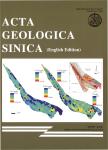V_p/V_s Anisotropy and Implications for Crustal Composition Identification and Earthquake Prediction
V_p/V_s Anisotropy and Implications for Crustal Composition Identification and Earthquake Prediction作者机构:Departement des Genies Civil Geologique et des Mines Ecole Polytechnique de Montreal Montreal H3C 3A7 Canada Key Laboratory of Continental Dynamics Ministry of Land and Resources Chinese Academy of Geological Sciences 10037 Beijing China
出 版 物:《Acta Geologica Sinica(English Edition)》 (地质学报(英文版))
年 卷 期:2009年第83卷第4期
页 面:801-815页
核心收录:
学科分类:070801[理学-固体地球物理学] 07[理学] 0708[理学-地球物理学]
基 金:funded by the Natural Sciences and Engineering Council of Canada and the Geological Survey of China
主 题:Vp/Vs ratio Seismic anisotropy Crustal composition Earthquake prediction
摘 要:The ratio of P- to S-wave velocities (Vp/Vs) is regarded as one of the most diagnostic properties of natural rocks. It has been used as a discriminant of composition for the continental crust and provides valuable constraints on its formation and evolution processes. Furthermore, the spatial and temporal changes in Vp/Vs before and after earthquakes are probably the most promising avenue to understanding the source mechanics and possibly predicting earthquakes. Here we calibrate the variations in Vp/Vs in dry, anisotropic crustal rocks and provide a set of basic information for the interpretation of future seismic data from the Wenchuan earthquake Fault zone Scientific Drilling (WFSD) project and other surveys. Vp/Vs is a constant (Ф0) for an isotropic rock. However, most of crustal rocks are anisotropic due to lattice-preferred orientations of anisotropic minerals (e.g., mica, amphibole, plagioclase and pyroxene) and cracks as well as thin compositional layering. The Vp/Vs ratio of an anisotropic rock measured along a selected pair of propagation-vibration directions is an apparent value (Фy) that is significantly different from the value for its isotropic counterpart (Ф0). The usefulness of apparent Vp/Vs ratios as a diagnostic of crustal composition depends largely on rock seismic anisotropy. A 5% of P- and S-wave velocity anisotropy is sufficient to make it impossible to determine the crustal composition using the conventional criteria (Vp/Vs≤1.756 for felsic rocks, 1.756〈Vp/Vs≤1.809 for intermediate rocks, 1.809〈Vp/Vs≤1.944 for mafic rocks, and Vp/V2〉1.944 fluidfilled porous/fractured or partially molten rocks) if the information about the wave propagation-polarization directions with respect to the tectonic framework is unknown. However, the variations in Vp/Vs measured from borehole seismic experiments can be readily interpreted according to the orientations of the ray path and the polarization of the shear waves with respect to the present-day principal stre



